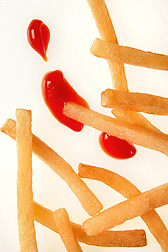This page has been archived and is being provided for reference purposes only. The page is no longer being updated, and therefore, links on the page may be invalid.
| Read the magazine story to find out more. |
|
|
French Fries' Oil Content: It's Lower with Infrared Heat
By Marcia WoodJuly 26, 2013
French fries typically soak up a lot of oil while they're in the deep-fat fryer. But U.S. Department of Agriculture (USDA) scientist Zhongli Pan and his colleagues have shown that prepping the raw fries for three minutes with infrared (IR) heat, before the fries are dunked in the fryer, can reduce oil uptake by about one-third, as compared to raw fries not treated with IR.
An article in the July 2013 issue of Agricultural Research, an online magazine from the Agricultural Research Service (ARS), describes the experiments. ARS is USDA's principal intramural scientific research agency.
Pan's team made hundreds of fries—about 20 pounds in all—to determine the combination of IR heating times and intensities, and deep-frying times and temperatures, that would yield appetizing fries with less oil.
Of the 77 volunteer taste-testers who sampled the fries, more than half said they found the taste and color of the IR-prepped fries to be no different from that of conventionally prepared fries. More than half of the panelists said they preferred the IR fries' crunchier texture, according to Pan.
The IR unit that his group experimented with heated just the top and the bottom of the fries. Pan noted that an IR unit that heats all surfaces of the fries might lower the fries' fat content even further than the 37.1 percent reduction that the team achieved.
Pan also noted that although the group's published data was based on experiments with fresh fries, IR prep is also suitable for fries that are partially processed at potato processing plants. After partial processing, the fries are frozen and then shipped for later "finish frying" at restaurants, cafeterias or other eateries.
The idea of prepping fries to help reduce oil uptake isn't new. But the experiments that Pan led are apparently the first to extensively explore IR as a prepping option for fresh or partially processed French fries.
Pan is an agricultural engineer at the ARS Western Regional Research Center in Albany, Calif. He and Tara H. McHugh, a food technologist and research leader at the Albany center, and other collaborators published their findings in 2012 in Food Chemistry.
ARS and the Washington State Potato Commission funded the research.

